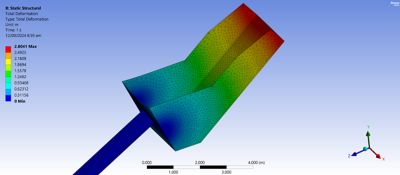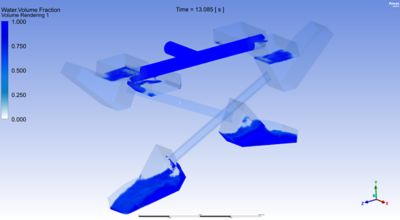Case Study
-
United States -
United Kingdom -
India -
France -
Deutschland -
Italia -
日本 -
대한민국 -
中国 -
台灣
-
Ansysは、シミュレーションエンジニアリングソフトウェアを学生に無償で提供することで、未来を拓く学生たちの助けとなることを目指しています。
-
Ansysは、シミュレーションエンジニアリングソフトウェアを学生に無償で提供することで、未来を拓く学生たちの助けとなることを目指しています。
-
Ansysは、シミュレーションエンジニアリングソフトウェアを学生に無償で提供することで、未来を拓く学生たちの助けとなることを目指しています。
“Integrating Ansys static structural and transient structural analyses into our research project provided crucial insights into both the static and dynamic behaviors of our system, ensuring structural integrity and optimizing performance. Ansys Fluent software further enhanced our design by simulating fluid dynamics, predicting potential issues, and refining the system for greater efficiency.”
— Ronald Simeon Eiselstein, President, Replenish Waterpower LLC
The Eiselstein energy converter technology, a revolutionary technique to generate electricity from hydropower using levers, faced significant hurdles in proceeding to physical prototyping due to high costs and the need for optimization. To address this, with support from CAD-IT Consultants (Asia) Pte. Ltd., Replenish Waterpower LLC used Ansys’ multiphysics tools, which enabled the team to accurately model and analyze the system. This technique enabled iterative design revision and optimization of system components and performance while remaining within the engineering and budgetary limits before proceeding to prototyping.
Challenges
Optimized technology design is crucial for efficient power generation, as it directly impacts the system's ability to convert hydro energy into electrical energy. The system employs an Archimedes lever, in which each lever carries a tank that alternately fills and empties with water. The rise and fall of these lever arms serve as the mechanism for generating electricity, making the design parameters essential for maximizing power output.
Key elements such as the size and shape of the levers and tanks, their angular velocity, and valve configurations are critical in determining the system's capacity to consistently and efficiently harness hydro energy. Additionally, factors like fluid dynamics and the interaction between water and the system’s components play an important role in influencing power generation. When properly designed, these elements work together to optimize the system's performance, ensuring that the energy generated from the movement of water is maximized for electricity production.
Physically constructing the technology without extensive analysis may not guarantee the desired power generation, as the physical build might underperform and become costly despite relying on analytical design concepts. Therefore, Replenish Waterpower LLC initially focused on meticulously designing these elements through analytical and numerical simulation methods. This approach enabled quick adjustments and the testing of design alternatives without the need to build multiple prototypes. Ansys Fluent software and the Ansys Mechanical solution were considered for numerical simulation analysis because of their ability to solve complex simulation problems.

Result of the static structural analysis for the lever and tank
Engineering Solutions
The flow analysis process began with system conceptualization, advancing through detailed design and simulation phases. The first step involved defining the system's objectives and constraints, followed by developing a conceptual design that integrated key components and their interactions. This stage included generating engineering drawings and establishing boundary conditions. Once the initial design was finalized, the team proceeded to the simulation phase.
Mechanical software was used for these purposes. The Static Structural tool was used to validate parameters for levers and tanks, yielding critical insights into von Mises stress, as well as maximum and principal stresses.
To evaluate the dynamic behavior of the tanks, we conducted a transient analysis using the transient structural tool. This provided key metrics such as angular velocity and angular displacement, as well as lever and tank descent times.
For a comprehensive fluid dynamics analysis, Fluent software was used to simulate the interaction of water with system components. A user-defined function (UDF) was implemented to model the lever and tank descent motion, along with valve rotation during water flow in the system. After setting the boundary conditions, different scenarios with varying water velocities were tested to validate the system's ability to withstand the dynamic forces exerted by water flow.


Ansys Fluent software setup progression: Image A at 5 seconds vs. Image B at 13 seconds
Benefits
The integration of static structural and transient structural analyses provided comprehensive insights into both static and dynamic behaviors of the system. The static structural analysis yielded critical data on von Mises stress and principal stresses, which were essential for ensuring that structural components such as levers and tanks could withstand operational stresses without failure. Meanwhile, the transient analysis offered valuable information on angular velocity, angular displacement, and descent time, enhancing our understanding of the system’s dynamic behavior.
Additionally, Fluent software enabled Replenish Waterpower to simulate fluid dynamics, which was crucial for identifying potential inefficiencies within the system. By observing how water interacts and behaves within the system and optimizing flow rates, we were able to refine the design for better performance and efficiency. This simulation also allowed us to predict and mitigate potential fluid-related issues.
Overall, using these simulations provided several benefits. The early identification of issues helped reduce the risk of costly errors and redesigns. Simulations also saved time and effort by enabling virtual testing and optimization before physical prototypes were built. Additionally, addressing both structural and fluid dynamic aspects enhanced the design’s efficiency, leading to a more reliable and effective system.
This comprehensive approach allowed Replenish Waterpower to significantly improve the overall system design by addressing both structural and fluid dynamic aspects.
Ansysができること
Ansysができること
お問い合わせ
お問い合わせいただき、ありがとうございます。
当社はお客様の質問にお答えし、お客様とお話できることを楽しみにしています。Ansysの営業担当が折り返しご連絡いたします。











